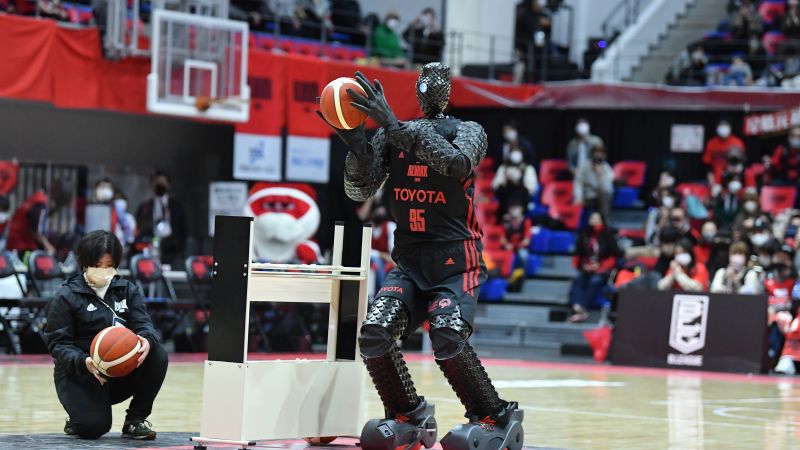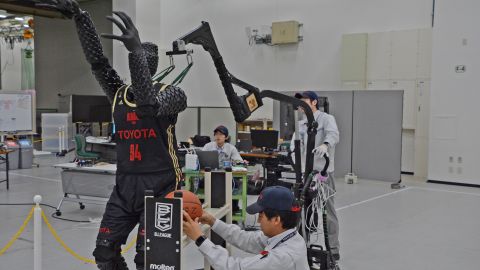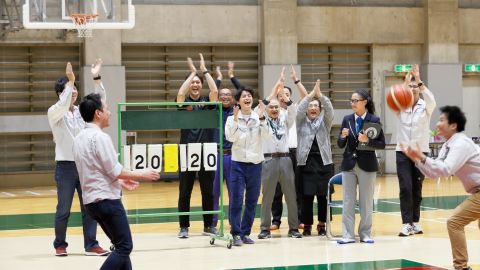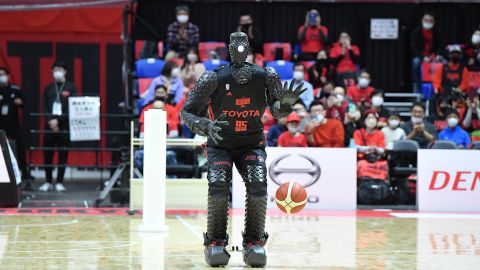
CNN
—
At nearly seven feet tall and weighing 240 pounds, CUE has biometrics a lot like the average basketball player’s. But CUE isn’t a sports star in the conventional sense: it’s a hoop-shooting AI-powered robot.
At the Olympic Games in Tokyo, in the Summer of 2021, it wowed spectators with a nothing-but-net shot from half court.
“At that moment, I felt like I was watching a fantasy movie (rather than) something I had been a part of,” says Tomohiro Nomi, leader of the development team behind CUE and other Toyota humanoid robot projects.
CUE, which uses a sensor in its chest to calculate the angle and power required for each shot, originated as an amateur robotics project in 2017, and it achieved the “impossible” by appearing in a half-time show at the Olympics, Nomi says.
However, after landing more than 2,000 consecutive shots in a world-record attempt, shooting hoops has become too easy for this sporty droid.
To spice things up, the team is teaching the robot to dribble – and hope future iterations will have “the same range of motion and flexibility as humans,” says Nomi.
The Toyota team behind CUE conceived of the idea during an AI-themed event at a volunteer organization called the Toyota Engineering Society. Inspired by a phrase from a 1990s basketball manga series titled “Slam Dunk” – “Will 20,000 practice shots be enough?” – the team set out to create a robotic player capable of 100% accuracy.

Just 11 months later, the first version of the robot made its debut at a game featuring Alvark Tokyo, a team from the top division of Japanese basketball league, the B.League. It successfully scored nine out of 10 shots from the free-throw line. After this result, Toyota asked the nine-person development team to pursue it as an official project.
In the second version, the team removed the robot’s stand and instead made it stand on two legs, which increased its shooting range to seven meters (23 feet). For the third iteration, the robot could now shoot from the center circle, 12 meters (39 feet) from the basket. It was this model, CUE3, that was offered the chance to try out for the Guinness World Record for the title “Most consecutive basketball free throws by a humanoid robot (assisted)” in April 2019.
The team had to reduce the time needed to tee up its next shot, from three minutes to just seconds for the shots to be considered consecutive. The robot set the record at 2,020 consecutive shots – a number that was chosen to celebrate the Tokyo 2020 Olympics – over six hours and 35 minutes. That still doesn’t beat the human record of 5,221 free throws set in 1996, but CUE’s development team note that they deliberately cut the attempt short due to time constraints, as record officiators cannot take breaks, swap or leave.

As the robot evolved, so did its height and weight; it is now 9 inches taller than its shortest iteration and nearly twice as heavy as its lightest. The added weight is a disadvantage, says Nomi, and the team would like to make it lighter – however, he adds that they have “prioritized functional evolution in the limited time available,” over a nimbler body.
The robot’s latest version, CUE5, was unveiled at the Tokyo 2020 Olympics, at the request of the International Olympic Committee (IOC). While the half-time exhibition wasn’t broadcast on television, many videos of it circulated on social media.
With new cameras and sensors installed in its feet and new movement in its hands, CUE can now detect the distance between its palms and the ball – allowing it to dribble, and take shots from multiple positions on the court, including from half-court.
“We would like to try shooting from even further distances in the future – for example, from the 3-point line on the opposite court or from the free-throw line,” says Nomi.
The team is still honing CUE’s dribbling ability – but this new skill presents a world of possibilities.
Their next goal is to get CUE6 a spot at the 2023 B.League All-Star Game Skills Challenge, which tests players’ speed and precision in dribbling, shooting, passing, and obstacle navigation. The team aims for the droid to complete the test in one minute, which is on par with the average time of top athletes.

However, this new mission brings “a mountain of challenges” according to Takayoshi Tsujimoto, the team’s development manager, who said in a statement that “whereas a shot essentially flies in a parabolic arc, a pass must take a more direct course.”
The team now needs to double the speed that the current version of CUE runs at, establish whether one or two-handed throws work better, as well as add zig-zag running motions and obstacle sensors, Tsujimoto adds. And the team don’t have long: CUE6 is expected to debut at an Alvark Tokyo home game on December 24, 2022, says Nomi.
While robots cannot yet mimic human movement, Nomi anticipates technological advancements that will get them closer to that goal. The team hasn’t looked at specific industrial applications for the technology yet, but Nomi thinks that the type of control system CUE uses could be useful across the robotics field.
Whenever the team faces challenges, he comes back to the idea of taking 20,000 practice shots to succeed – and thinks it contains an important reminder for innovators.
“That number would normally make someone wince, but it’s as if to say, ‘Is that all I need to do?’ It sends out a strong message – of never using being an amateur as an excuse, and that hard work pays off,” he says.
“These messages push us forward.”
